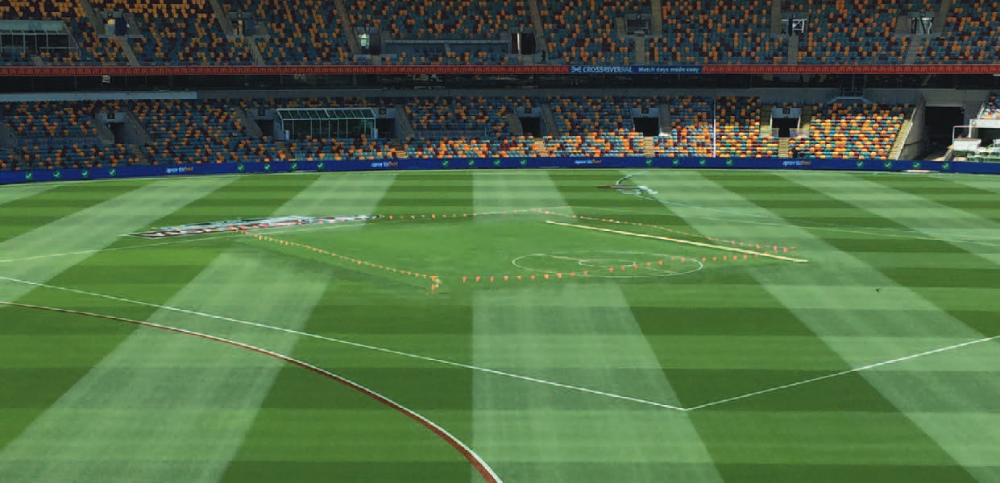Golf Course Autumn Renovations: Strobilurin Suitability and the Potassium Pendulum
Autumn renovations are upon us for those managing bent greens. The struggle of summer heat is gone, the turf is back in an active growth phase, and we have an opportunity to renovate our greens for continued health and performance. The autumn renovations often involve a whole suite of actions, amendments and applications, but for this note we will look at two complementary (albeit quite independent) tools in particular – the use of strobilurin fungicides as a key protection measure and the use of potassium both at renovation and beyond renovation.

The strobilurin suitability
The strobilurins have long had a moderate risk classification for resistance. It is for this reason a common guide provided for their use is to limit the strobilurins to no more than one third of a program – and rotate amongst as many groups as possible for the other two thirds. This has meant we needed to be both selective and judicious in our deployment of the strobilurins and consistent with this guide three windows are commonly targeted in the management of greens in golf. Autumn renovations are the first window that is arrived at on the calendar, the second is spring renovations and the third is the sensitive Christmas / New Year period.
Why is Strobilurin use (and specifically Azoxystrobin) suitable for reno’s? because it has the highly desirable combination of very broad spectrum, excellent longevity of function, and efficient root uptake when applied to the soil allowing whole of plant protection. When we renovate we do ask quite a lot of the turf plant – albeit with very good intentions. We interfere with the surrounding soil and foliar physical structure (aeration, scarifying, topdressing) and rely on strong recovery behaviours for a successful rejuvenation process. The physical forces imparted by renovation equipment do cause injury and because of this a vulnerable window is created for opportunistic pathogens to attack. The strobilurin chemistry application looks to counter this vulnerability and for a set window of time offers broad spectrum, highly reliable and strong defense against threats. But timing is critical…
The strobilurins don’t move with the speed of the triazoles – this can be good and bad. Good if you use them properly i.e. before issues exist, bad if you have a raging infection and you apply well into the attack phase as you may be disappointed. Understanding this is important to ensure expectations are appropriate and timing of use is optimized. In the context of turf renovation best results will be achieved if applied via a soil application in the days prior to the commencement of renovations. Those few days allow the soil reservoir to be generated and primed for the plants plumbing to draw upon. It allows this slower moving chemistry to enter the plant and begin dosing the full plant structures prior to, and throughout, the critical days of actual renovation works. If well timed then the duration of activity should also carry you through the early post renovation stabilization period till recovery is well under way – and you are on track to produce happy and healthy turf once again.
It is the understanding and appreciation of key behavioural traits of chemistries that allow turf managers to get maximum bang for their buck. Knowing about differences in solubility, mobility, speed of movement and spectrum, as well as post application travel allows the sensible, effective and appropriate use of the tools available.
The potassium pendulum
In this note we elected to tackle a critical protection tool (strobilurin fungicide) but also a critical nutritional requirement – potassium, as both have a fit in the autumn renovation plan. Over the last 50 years potassium seems to have had the biggest fluctuations in opinion of importance. Possibly we are getting closer to right but it has taken extreme swings to get to the sensible centre. In saying that there is probably plenty who would argue we are still not there – one direction or the other.
What is not in doubt is the diverse and very important roles potassium plays in the healthy function of plants. Unfortunately, when examining the what’s and how’s of Potassium functionality it would seem it is more a facilitator than a direct doer so it probably doesn’t get the credit it deserves. In certain turf management situations (think sand profile greens) we can get the concurrent challenge of it running short in soil and simultaneously having internal reservoirs rapidly depleted when turf is cut frequently. The ‘indirect’ element means the product of these shortages may appear as symptoms not immediately correlated to the potassium shortage – e.g. possibly in water management and cell turgidity. We think we need more water or further wetting agent but they might otherwise be ok.
Potassium is physically smaller than some other cations and carries one less charge than the more glamourous Ca and Mg so in soils it can be more easily out-competed by sodium for location on exchange sites and can be bumped off when the K / Na balance shifts the wrong way in irrigation water.
Once inside the plant potassium has quite a lot to claim. It is well documented to play a role in the function of many enzymes that are fundamental to biochemical reactions in plants, is a key contributor to the production of ATP (the energy molecule that is a driver of many processes including respiration and photosynthesis), plays a role in the transport of sugars and starch, and as mentioned prior has an absolutely vital role to play in water relations through impacts conferred to guard cells that control turgor pressure, water loss and wilt. It is the last point that possibly needs to be re-iterated again as so many related issues are created when water is poorly managed or unnecessarily lost.
With potassium being so critical to the opening and closing of stomates, which in turn is so greatly affects the two big processes of photosynthesis and respiration, the focus we place on it seems like it should be so acute but the fact the relationship is indirect might be why sometimes it gets missed. If we apply N or Fe the results can be quite tangible and definitely visible, but for K it is sometimes delayed or not directly linked. A shortage of K can allow structural issues or wilts, but this would be considered caused by something else before the K was directly implicated. Possibly K should be considered more frequently on par with N when we look at nutrition and plant health. They are both needed in good quantities in fine turf and both seem to have multiple mechanisms by which they affect water relationships.
Maybe we should consider K to be like the guy in the workplace who says little, behaves quite reclusive at times, but gets through an absolute mountain of work doing things so important to business function, yet gets little of the attention. Other people get more accolades and awards but every business needs those guys and our turf needs that nutrient.
With the autumn renovation window in mind some of the other benefits conferred by potassium become quite focal. Things like structural strength and resilience. One of the watch outs is that a shortage of potassium won’t be immediately apparent as its old growth that is impacted before new growth. If your sole focus is looking at new growing points then a shortage may be missed. Worth watching.
How Nuturf can help you
Nuturf stock straight strobilurin chemistries as well as combination products with triazole fungicides for even broader spectrum.
We can assist with further technical advice in understanding the different attributes of the chemistries available, practical tips on the application process looking for optimization of treatments and further advice on relevance to renovations in terms of timings, scheduling and compatibility with other cultural practices.
We offer multiple nutritional products with varying loadings of potassium. We have some novel technologies that employ two types of slow release potassium to absolutely optimize the dosing and delivery of this critical nutrient to your turf.












